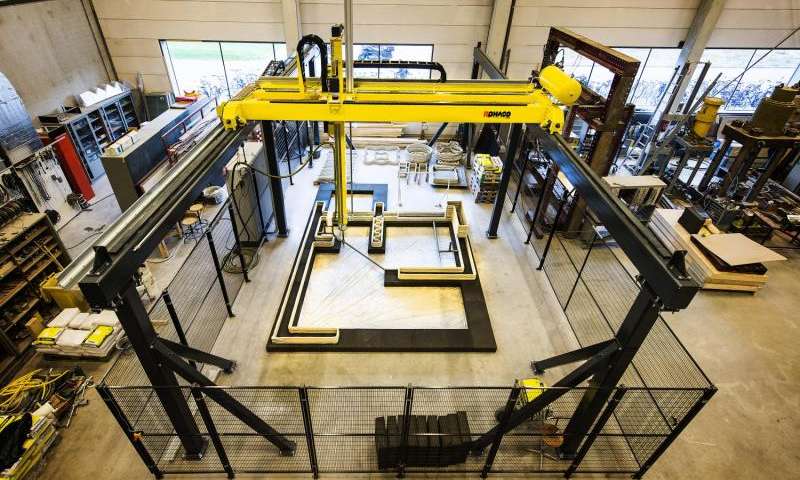Table Of Content

Generally, they are more eco-friendly, affordable and efficient compared to traditional housing construction. However, it’s important to know the limitations of this new method of construction. In Houston, a giant printer is building what designers say is the first 3D-printed two-story house in the U.S. If one bedroom is all you need, this floorplan will help you create the perfect 3D printed house to fit your simple lifestyle with plenty of legroom. With an extra spacious bedroom and roomy bathroom, this floorplan still includes a nice-sized living room and seated countertop for dining, lounging, or entertaining. While there are references to 24-hour construction times in articles and advertisements touting 3D printed homes, no project has been able to demonstrate such a record.
How to 3D Print an Entire House in a Single Day
Video: Europe's biggest 3D-printed building rises in just 140 hours - New Atlas
Video: Europe's biggest 3D-printed building rises in just 140 hours.
Posted: Wed, 06 Mar 2024 08:00:00 GMT [source]
There are many ways to decorate and accentuate a 3D printed home to gives a nod to its unique origins. SQ4D builds full-size concrete houses and commercial structures faster, safer, and stronger, while dramatically reducing costs, using 3D printing technology. While 3D printed houses are durable and resistant to climatic conditions, they have not yet been shown to perform better than conventional houses made of wood and bio-based materials. 3D-printed houses cost about $10,000 to $400,000 on average, but pricing can vary based on the house’s location, size, amenities and materials used. Aside from time and money, several other reasons explain additive manufacturing’s disruption to the construction market.
First family move into a 3D printed house in France
Its sustainable design uses low-energy floor and ceiling heating, sourced from solar panels and a heat pump. In December of 2021 Alquist became synonymous with 3D concrete printing (3DCP) by completing the first owner-occupied 3D printed home in the world. Alquist uses 3D printing technology to create exceptional design while lowering the cost of housing and infrastructure. After 6+ years of research, and working with multiple machines and materials, Alquist continues to be a leader in the industry.Alquist’s approach to 3DCP has been unique in our emerging industry. As 3DCP continues to emerge, Alquist took the route of becoming a construction company – as opposed to a manufacturer. Our goal is to become experts on a wide variety of different types of printers, materials, and methods in order to expand our understanding and gain insightful knowledge of the best practices for the future of this industry.
The 6 Main Types of FDM 3D Printer Explained
Portugal's Havelar shows this may soon be within reach with its inaugural 3D-printed home, which took just 18 hours to print. They sell their very own concrete construction 3D printer, the BEM Pro 2, which can operate even in hot and harsh climates, making it great for 3D printing houses near the equator. WASP’s breakthrough came in 2018 when they released the Crane WASP, the first modular, multi-stage 3D printer in the market. The 3D printing system that can be readjusted to meet the demands of small and large house construction spaces. The East 17th Street Residences in East Austin are another member of ICON’s family of 3D printed homes. Designed by Logan Architecture, the houses are the first 3D-printed homes for sale in the U.S.
Build beautiful, sustainable communities
Currently, CyBe aims to build the world’s first four-story apartment building in conjunction with Dutch housing developer, Lab040. Using the CyBe G printer, the complex is set to be constructed in the Netherlands and will feature six apartments. ICON’s Vulcan construction system 3D printed the walls of House Zero in less than two weeks using a proprietary cement-like material, insulation, and reinforced steel. Using only these 3 raw materials, this process drastically cuts down construction times and raw materials. The homes are designed by the Bjarke Ingels Group (BIG) and prices range from $450,000 to $600,000, serving a blend of modern architecture and innovative construction technology.
ICON
I love 3D printed homes with intricate landscaping and an aesthetically pleasing use of materials. Someday if I build my own 3D printed home, I plan to design the exterior using an abundance of neutral colors like cream, gray, and beige. In South Africa, CyBE is teaming up with the SAHIF (South African Housing & Infrastructure Fund) to construct the first South African 3D printed houses to bring more affordable houses in the country.
The homebuilding industry is on the edge of a revolution.
As a guy with a natural fascination for both building houses and technology, the idea of 3D printing a house is right up my alley. Checking out examples of 3D printed tiny houses gets me excited about my own future as a tiny house builder. These four Austin, Texas properties by construction 3D-printing company ICON feature open-floor plans, minimal architectural aesthetics and private yards. Varying in size, these residences feature two to four bedrooms and range from 1,000 to 2,000-square-foot homes.
Revolutionizing Construction
If you prefer a home with more bells and whistles as your primary residence, you may still want to consider a 3D-printed home as a second home. Speed through design and assembly with less skilled labor and get faster returns on investment. This California development features 30 homes with 3 beds / 2.5 baths, measuring 2,299 sq. Ft. which can be installed in 4 months with a 3-person crew using standard machinery.

Where can we buy hurricane proof prefab homes in Florida?
NASA has designed, with the company ICON, a 170 m2 3D printed habitat in order to simulate a mission to the Moon (Project Olympus), where buildings could be constructed using resources found on the Moon. For the moment, therefore, unless we use local bio-sourced elements as was done for the Tecla project, the 3D printing of buildings should be limited to these extra-planetary projects... Project Milestone — which consists of five 3D-printed concrete dwellings — was the world’s first commercial housing project in its medium, with full intent to legally house residents. The first of these 1,011-square-foot dwellings was printed in 120 hours on-site as 24 separate parts. Matching their backdrop of Eindhoven, a techy city in the Netherlands known for its cutting-edge design, Project Milestone houses resemble elongated boulders with smooth, rounded edges. With extra-thick insulation and a connection to the heat grid, these structures score high marks in energy efficiency, according to online media platform 3D Natives.
"It looked like a nice house in the mock-ups, but my main concern was that the technology was new—I wondered who would actually know how to work on the house if something went wrong." The competition is being held in two phases with submissions for the first phase due on December 8th of 2023. Between the two phases, the company is awarding $1 million and plans to build and showcase the winning designs. ICON started its journey in 2018 when founders Jason Ballard, Alex Le Roux and Evan Loomis promised to 3D print a model home and unveil it at the South by Southwest Festival (SXSW) in Austin, Texas. Through lots of trial and error, the team was able to produce a home with only hours to spare before the unveiling.
By automating construction, building with ARCS is safer for workers than any alternative. Using a larsen truss system, for example, is a quick and effective way to build a very efficient structore from biosourced materials. But there are certainly logistical issues with this recycling alternative, as well as potential health issues related to living in a home made from recycled plastic. According to the Graham Construction Material and Commodity Review, published in May 2021, the cost of concrete is expected to rise with sand shortages and the residential and commercial construction boom.
To help accelerate humanity’s expansion into the stars, ICON now offers robotic arms, actuators, simulants, and testing facilities to fellow private space startups and companies. Construction waste was nearly eliminated due to the precision of the printing process. Comprising 3D-printed floors, walls and roofs of wood fibers and bio-resins, the home is fully recyclable and highly insulated with 100% wood insulation and customizable R-values. Designed utilizing clay sourced locally from a nearby riverbed and printed in Massa Lombarda – this home is formed of two connected dome-shaped volumes with a ribbed outer wall that is made up of 350 stacked layers of 3D-printed clay. Embodying an organic geometry – this space includes an open-plan kitchen-diner and living area that occupies over half of the floor plan, while a large double bedroom and bathroom are contained within the remainder of the home. Simply put, three-dimensional shapes are at first designed through a computer-controlled process without the use of formwork.
If the figures are far from reality, it is because the information conveyed omits the fact that these times concern only the main house walls! It never takes into account the foundations, roofs, windows, doors, interior and exterior finishes, plumbing, etc. To 3D print a house, it may take about 24 hours to three weeks, excluding time for second-fix installations or material transportation if pieces are not printed at the final house location. Known as House Zero, the mid-century, ranch-style luxury home is a 2,000-square-foot property with a 350-square-foot accessory dwelling unit.
There are also companies that will take your building plans and create walls to match that can be delivered and assembled, that can be a great option as it is often cheaper as there is less material waste. And, you’re not leaving your wood frame exposed out in the rain for weeks or months to get saturated and warped. The construction industry in Canada is currently facing a shortage of skilled labour. Since 3D printing requires fewer people for framing, it offers a certain advantage here.
Each ground floor level is built with a proprietary cement-based material, dubbed “Lavacrete,” to last longer than traditional construction materials, according to the company’s website. The second story incorporates old-school methods, and is constructed out of black metal cladding and rich-colored timber. Three-dimensional-printed houses are life-size dwellings that use 3D printing as its primary means of construction. With minimal human oversight, these highly customizable structures can be built on-site or off-site within a matter of hours at a fraction of the cost. 3D printed houses are likely not as cheap as the companies who have built 3D printed houses claim they are. Therefore, 3D printed houses offer a solution to this lack of skilled builder problem.
Comishin formerly worked in robotics, where he introduced CNC technology to the skateboarding industry. He then worked in green energy for the better part of the decade, specifically in automation manufacturing of wind turbine blades. After exiting the role (and signing a non-compete disclosure in wind energy), Comishin was looking for a field with similar development. He noticed a crossover between what was happening in the 3D printing industry and with CNC technology. “We develop different types of printers, whereas all of our competitors have their one printer that they are trying to get out on the market,” says Ian Comishin, TAM’s president and co-founder, to STOREYS.












